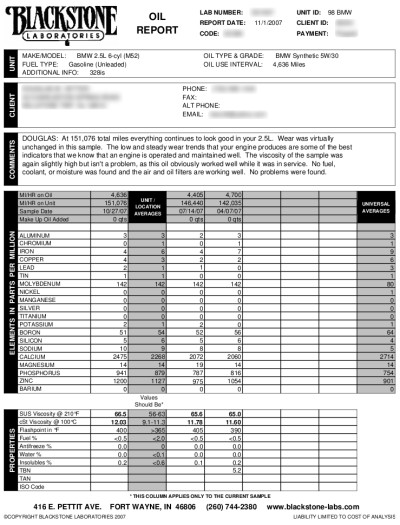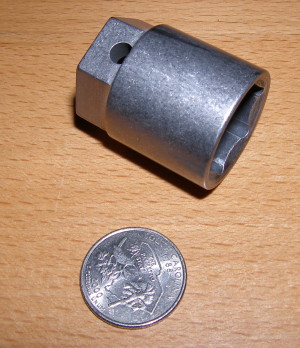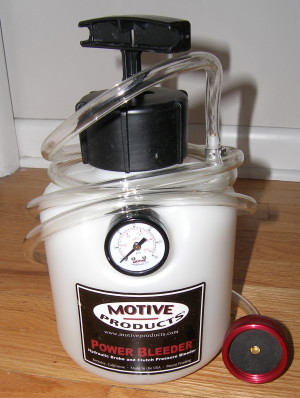Saturday, October 27, 2007
Oil Service and Analysis
 After 4600 miles
I performed another DIY oil service and analysis. When I went to pick up the
oil and filter at the dealer the parts guys asked where I'd been lately, so
I told them the truth: the car has been performing beautifully
and I was enjoying the "time off".
After 4600 miles
I performed another DIY oil service and analysis. When I went to pick up the
oil and filter at the dealer the parts guys asked where I'd been lately, so
I told them the truth: the car has been performing beautifully
and I was enjoying the "time off".
The report shows that Zinc, Phosphorus, and Calcium are all higher than the previous two reports, but those are detergents / dispersants added to the oil, and more is usually better. Lead, Tin, and Copper (bushings / bearings) are higher, but still below the universal averages. All in all, a great report. At this rate, I'm doing an oil service every three months, so the next one should occur early next year...probably mid-late January because of all the traveling around the holidays.
Engine Air Filter
My handy maintenance schedule also pointed out that it had been 30K miles since I last replaced the engine air filter, so I picked up another OE unit and installed it. I should point out that I usually pull the filter at every oil service (4500 miles) and tap it on a rigid (and clean) surface to free the bulk of the dirt and sand that finds its way into the filter. If you've never done that before you might be surprised at how much debris the OE engine filters trap.
Many people discount the importance of an air filter and install free-flowing units (K&N or equivalent) in a quest for more horsepower but not only do the oil-based filters cause issues with the mass air flow sensor, but a free-flowing air filter is free-flowing for a reason -- it doesn't filter as well as the OE paper filter.
I recently read an account online of a guy who started doing analysis following an engine conversion on a Z3 and he noticed a spike in silicon in the analysis after switching to a K&N unit. High silicon in an oil analysis means that fine grains of sand are getting past the filter and being ingested by the engine. Silicon is a strong abrasive so needless to say its presence can significantly increase engine wear. Is a couple horsepower worth the extra wear and tear on the engine? I think not.
Cold Start Issue Update
In the last maintenance update I mentioned I was still experiencing the cold start issue. A bit over a month later I can say that the problem comes and goes, and it's mostly gone at the moment. It was a bit worse when burning through the tank with the fuel system treatment, but it's better now. Not only does the car start a bit more easily but it seems to be a bit more fuel efficient as well.
 This car has averaged
24.3 MPG from when it was new and so I consider that
the benchmark. Mileage had dropped to 23.8 after I put the 18" wheels on the
car, but in the few tanks since I added the fuel system treatment it's climbed
to 24.8. If we were still burning MTBE laced fuels I'd attribute this increase
to the change to the removal of MTBE around this time of year, but
the oil companies don't change the E10 formulation with the seasons...or so
we're told. If the fuel formulation is the same, then the increase is
due to the fuel system treatment.
This car has averaged
24.3 MPG from when it was new and so I consider that
the benchmark. Mileage had dropped to 23.8 after I put the 18" wheels on the
car, but in the few tanks since I added the fuel system treatment it's climbed
to 24.8. If we were still burning MTBE laced fuels I'd attribute this increase
to the change to the removal of MTBE around this time of year, but
the oil companies don't change the E10 formulation with the seasons...or so
we're told. If the fuel formulation is the same, then the increase is
due to the fuel system treatment.
This experience lends credibility to the belief that fuel injectors need to be cleaned periodically. I may still pull the fuel injectors and have them professionally cleaned and flow balanced, but I need to find the time to do that.
Incidentally, I never did bother to get pressure readings on the fuel rail because I logically concluded that the cold starting was not caused by fuel pressure. A fuel leak would not fix itself.
Tools In Advance
The front struts are approaching 100K miles in service so they'll likely be replaced soon. While researching the subject I found out that one of the trickier parts of the job is keeping the strut rod from spinning while removing the top nut that secures the top bearing plate. It turns out that BMW has a special tool for this, but there is an equivalent in the aftermarket. It looks like a standard six point socket but its construction is such that it allows you to hold the rod while you rotate the nut. Some people use impact wrenches to work on the nut but I've been told by other people that doing that may damage the strut. I'm not going to take a chance with such an expensive part, so I consider $27 (or roughly $13 per strut) a small price to pay to save hundreds in labor.
 I finally decided to buy a brake bleeder so I could take over this
relatively simple task and pocket the $200 or so the dealer now charges.
The best way to bleed brakes is to enlist the aid of a helper to
push the brake pedal, but if you have to bleed solo you really only
have two options -- pressure and vacuum bleeders. I chose a pressure
bleeder because I read too many stories online of how vacuum bleeders
can leak around the bleeder fitting and introduce bubbles into the
line going to the waste bottle. This makes it difficult to determine
whether the air is coming from the system (and thus a successful
bleeding process) or from the leaking fitting. The dealer techs all
seem to use a vacuum bleeder so I'm going against the grain here,
but whatever -- I'll do what works for me.
I finally decided to buy a brake bleeder so I could take over this
relatively simple task and pocket the $200 or so the dealer now charges.
The best way to bleed brakes is to enlist the aid of a helper to
push the brake pedal, but if you have to bleed solo you really only
have two options -- pressure and vacuum bleeders. I chose a pressure
bleeder because I read too many stories online of how vacuum bleeders
can leak around the bleeder fitting and introduce bubbles into the
line going to the waste bottle. This makes it difficult to determine
whether the air is coming from the system (and thus a successful
bleeding process) or from the leaking fitting. The dealer techs all
seem to use a vacuum bleeder so I'm going against the grain here,
but whatever -- I'll do what works for me.
Modern pressure bleeders are little more than a plastic spray can with a pressure gauge and some special adapter fittings. While it's possible to make one up from scratch I knew that wouldn't be an effective use of my time, so I ordered a commercial unit. The $45 Motive "Euro" bleeder would have worked, but I decided to spend $20 more and get the "Black Label" bleeder because it comes with a machined aluminum cap that be less likely to crack as well as a swivel fitting that will prevent the hose from winding up or kinking as it is installed or removed from the reservoir.
Both of these tools are now featured in my tools article.
Mileage: 151076, Tools: $105, Parts (including Oil Analysis): $80



